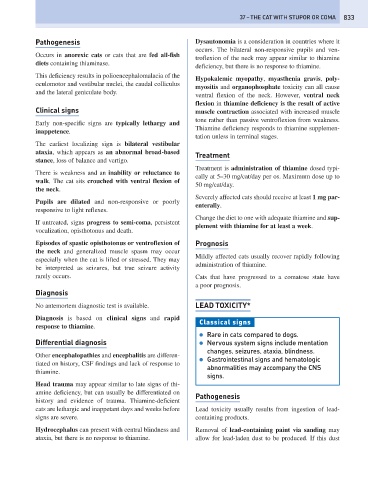Page 841 - Problem-Based Feline Medicine
P. 841
37 – THE CAT WITH STUPOR OR COMA 833
Pathogenesis Dysautonomia is a consideration in countries where it
occurs. The bilateral non-responsive pupils and ven-
Occurs in anorexic cats or cats that are fed all-fish
troflexion of the neck may appear similar to thiamine
diets containing thiaminase.
deficiency, but there is no response to thiamine.
This deficiency results in polioencephalomalacia of the
Hypokalemic myopathy, myasthenia gravis, poly-
oculomotor and vestibular nuclei, the caudal colliculus
myositis and organophosphate toxicity can all cause
and the lateral geniculate body.
ventral flexion of the neck. However, ventral neck
flexion in thiamine deficiency is the result of active
Clinical signs muscle contraction associated with increased muscle
tone rather than passive ventroflexion from weakness.
Early non-specific signs are typically lethargy and
Thiamine deficiency responds to thiamine supplemen-
inappetence.
tation unless in terminal stages.
The earliest localizing sign is bilateral vestibular
ataxia, which appears as an abnormal broad-based Treatment
stance, loss of balance and vertigo.
Treatment is administration of thiamine dosed typi-
There is weakness and an inability or reluctance to
cally at 5–30 mg/cat/day per os. Maximum dose up to
walk. The cat sits crouched with ventral flexion of
50 mg/cat/day.
the neck.
Severely affected cats should receive at least 1 mg par-
Pupils are dilated and non-responsive or poorly
enterally.
responsive to light reflexes.
Change the diet to one with adequate thiamine and sup-
If untreated, signs progress to semi-coma, persistent
plement with thiamine for at least a week.
vocalization, opisthotonus and death.
Episodes of spastic opisthotonus or ventroflexion of Prognosis
the neck and generalized muscle spasm may occur
Mildly affected cats usually recover rapidly following
especially when the cat is lifted or stressed. They may
administration of thiamine.
be interpreted as seizures, but true seizure activity
rarely occurs. Cats that have progressed to a comatose state have
a poor prognosis.
Diagnosis
No antemortem diagnostic test is available. LEAD TOXICITY*
Diagnosis is based on clinical signs and rapid
Classical signs
response to thiamine.
● Rare in cats compared to dogs.
Differential diagnosis ● Nervous system signs include mentation
changes, seizures, ataxia, blindness.
Other encephalopathies and encephalitis are differen-
● Gastrointestinal signs and hematologic
tiated on history, CSF findings and lack of response to
abnormalities may accompany the CNS
thiamine.
signs.
Head trauma may appear similar to late signs of thi-
amine deficiency, but can usually be differentiated on Pathogenesis
history and evidence of trauma. Thiamine-deficient
cats are lethargic and inappetant days and weeks before Lead toxicity usually results from ingestion of lead-
signs are severe. containing products.
Hydrocephalus can present with central blindness and Removal of lead-containing paint via sanding may
ataxia, but there is no response to thiamine. allow for lead-laden dust to be produced. If this dust

